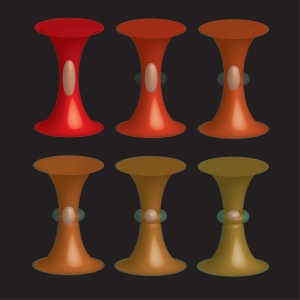Apr 9 2009
The ability to create tiny patterns is essential to the fabrication of computer chips and many other current and potential applications of nanotechnology. Yet, creating ever smaller features, through a widely-used process called photolithography, has required the use of ultraviolet light, which is difficult and expensive to work with.
 Schematic depictions of RAPID lithography, the technique developed by John Fourkas and colleagues which enables the creation of features 2500 times smaller than the width of a human hair.
Schematic depictions of RAPID lithography, the technique developed by John Fourkas and colleagues which enables the creation of features 2500 times smaller than the width of a human hair.
John Fourkas, Professor of Chemistry and Biochemistry in the University of Maryland College of Chemical and Life Sciences, and his research group have developed a new, table-top technique called RAPID (Resolution Augmentation through Photo-Induced Deactivation) lithography that makes it possible to create small features without the use of ultraviolet light. This research is to be published in Science magazine and released on Science Express on April 9, 2009.
Photolithography uses light to deposit or remove material and create patterns on a surface. There is usually a direct relationship between the wavelength of light used and the feature size created. Therefore, nanofabrication has depended on short wavelength ultraviolet light to generate ever smaller features.
"The RAPID lithography technique we have developed enables us to create patterns twenty times smaller than the wavelength of light employed,"explains Dr. Fourkas, "which means that it streamlines the nanofabrication process. We expect RAPID to find many applications in areas such as electronics, optics, and biomedical devices."
"If you have gotten a filling at the dentist in recent years,"says Fourkas, "you have seen that a viscous liquid is squirted into the cavity and a blue light is then used to harden it. A similar process of hardening using light is the first element of RAPID. Now imagine that your dentist could use a second light source to sculpt the filling by preventing it from hardening in certain places. We have developed a way of using a second light source to perform this sculpting, and it allows us to create features that are 2500 times smaller than the width of a human hair."
Both of the laser light sources used by Fourkas and his team were of the same color, the only difference being that the laser used to harden the material produced short bursts of light while the laser used to prevent hardening was on constantly. The second laser beam also passed through a special optic that allowed for sculpting of the hardened features in the desired shape.
"The fact that one laser is on constantly in RAPID makes this technique particularly easy to implement,"says Fourkas, "because there is no need to control the timing between two different pulsed lasers."
Fourkas and his team are currently working on improvements to RAPID lithography that they believe will make it possible to create features that are half of the size of the ones they have demonstrated to date.